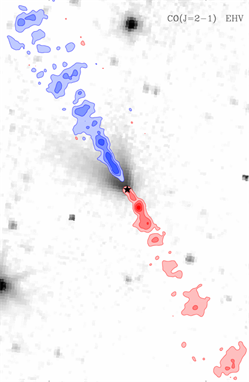Observatorio Astronómico Nacional
Infraestructura científica con más de 200 años

Formación de estrellas
Aunque la mayoría de las estrellas que vemos en nuestra Galaxia nacieron hace mucho tiempo (cientos o miles de millones de años), en algunas regiones podemos observar estrellas que se están formando en la actualidad. Entender cómo sucede este proceso constituye uno de los retos pendientes de la astronomía moderna, y a él se dedica en la actualidad un enorme esfuerzo teórico y observacional.
Fruto del esfuerzo investigador durante las últimas décadas, conocemos con cierta aproximación la secuencia de eventos que tiene lugar durante el relativamente corto proceso de nacimiento de una estrella (aproximadamente un millón de años).
Las estrellas nacen en gigantescas nubes de gas interestelar, que son acumulaciones de materia difusa producto de generaciones anteriores de estrellas que expulsaron su capas externas al morir. Esta materia va acumulándose en un proceso que dura decenas de millones de años, y en el que actúa una compleja mezcla de movimientos turbulentos, campos magnéticos, e interacciones gravitacionales. Como resultado de esa compleja combinación de interacciones, el material adquiere un aspecto caótico y filamentoso que recuerda al de las nubes de vapor de agua que se forman en la atmósfera.
En algunas partes de la nube, el gas alcanza una densidad suficientemente alta como para que la gravedad supere la acción estabilizadora combinada del campo magnético, la turbulencia, y la presión del gas. Cuando eso sucede, el gas pierde su estado de equilibrio y empieza a colapsar rápidamente para formar un objeto denso: la proto-estrella.
Esta proto-estrella consta de una condensación central aproximadamente esférica y de un disco de materia que gira a su alrededor. El disco está formado por materia con una velocidad inicial tan alta que no puede colapsar hacia el centro debido al fenómeno físico de conservación del momento angular, y constituye el embrión de un futuro sistema planetario alrededor de la estrella.
Perpendicular al disco, la proto-estrella emite un potente flujo bipolar que empieza a frenar el material que colapsa y disipar la condensación original de materia. Mientras tanto, el objeto central se va contrayendo lentamente hasta que su interior alcanza la densidad y temperatura necesarias para se produzcan espontáneamente reacciones nucleares. Cuando eso sucede, el proceso de formación se considera terminado. La estrella alcanza su edad adulta, o mas técnicamente, lo que llamamos "secuencia principal," fase en la que se encuentran la mayoría de estrellas que conocemos, incluido nuestro Sol.


